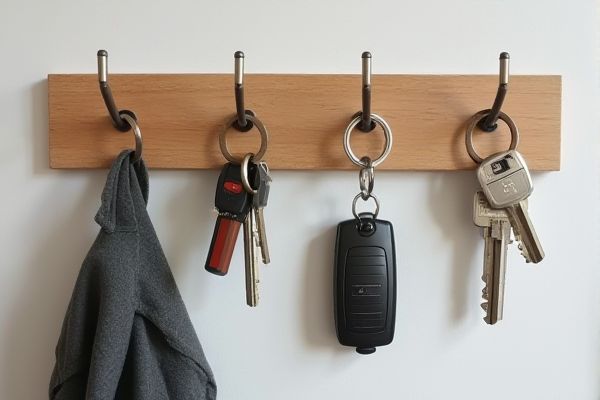
Magnetic key racks provide a sleek, space-saving solution by securely holding keys with strong magnets, while key hook boards offer a traditional, versatile option with multiple hooks for organizing various items. Explore this article to determine which option best suits Your organizational needs.
Table of Comparison
| Feature | Magnetic Key Rack | Key Hook Board |
|---|---|---|
| Design | Sleek, flat magnetic surface | Board with multiple hooks |
| Key Holding | Magnets hold keys without hooks | Keys hang on individual hooks |
| Capacity | Varies; limited by magnet strength | Dependent on number of hooks |
| Installation | Easy wall mount, minimal hardware | Wall mount or tabletop, screw-based |
| Durability | Sturdy magnets, less prone to wear | Hooks may loosen or bend over time |
| Organization | Minimalist, keys align flat | Separate hooks for clear order |
| Best Used For | Modern, compact spaces | Larger collections, easy key identification |
| Price Range | Moderate to high | Low to moderate |
Introduction to Magnetic Key Racks and Key Hook Boards
Magnetic key racks use strong magnets to securely hold keys without the need for hooks, offering a sleek, modern alternative to traditional key hook boards. Key hook boards feature multiple hooks, providing organized, accessible storage for keys and small items, often made from wood or metal for durability. Both options enhance entryway organization but cater to different aesthetic preferences and functional needs.
Design and Aesthetic Differences
Magnetic key racks feature sleek, minimalistic designs with concealed magnets that hold keys securely, often blending seamlessly into modern interiors. Key hook boards typically offer a more traditional aesthetic with visible hooks mounted on wooden or metal backboards, providing a rustic or industrial look. The choice between the two depends on whether a clean, contemporary style or a classic, tactile element better suits the space's design preferences.
Space-Saving Capabilities
Magnetic key racks maximize space efficiency by holding keys flat against the wall, reducing clutter and freeing up surface areas. Key hook boards require more room as keys hang outward, potentially protruding into walkways or countertops. Choosing a magnetic key rack enhances compact organization, ideal for tight spaces where every inch counts.
Installation and Setup Process
Magnetic key racks offer a straightforward installation process, often requiring only adhesive strips or magnets that attach directly to metal surfaces, eliminating the need for drilling holes. Key hook boards typically require mounting with screws or nails, which involves measuring, drilling, and securing the board onto a wall, making the setup more labor-intensive. Magnetic racks are ideal for quick, damage-free setups, while key hook boards provide a more permanent and sturdy solution.
Ease of Use and Accessibility
Magnetic key racks offer quick and effortless access by allowing you to simply attach your keys without fumbling for hooks, making them highly user-friendly. Key hook boards require you to manually hang each key on individual hooks, which can be less convenient, especially when in a hurry or for those with limited dexterity. Your choice depends on whether you prioritize the simplicity of magnetic attachment or the organized visibility provided by hook boards.
Durability and Material Quality
Magnetic key racks typically feature strong neodymium magnets embedded in high-quality materials like stainless steel or solid wood, ensuring long-lasting durability and resistance to wear and tear. Key hook boards are often made from wood, metal, or plastic, with metal hooks that can bend or loosen over time, which may reduce their lifespan. Choosing a magnetic key rack offers you enhanced structural integrity and a sleeker, maintenance-free solution compared to the mechanical stress-prone key hook boards.
Security and Key Organization
Magnetic key racks offer enhanced security by firmly holding keys in place using strong magnets, reducing the risk of keys falling or being easily removed by unauthorized individuals. Key hook boards provide a straightforward method for key organization with visible hooks, allowing quick access but potentially exposing keys to theft or loss. For environments prioritizing secure key management, magnetic key racks provide a more reliable solution compared to traditional key hook boards.
Maintenance and Cleaning Requirements
Magnetic key racks require minimal maintenance, as their smooth surfaces resist dust accumulation and can be easily wiped with a damp cloth. Key hook boards often need more frequent cleaning due to dust settling around hooks and potential rust buildup if made from metal. Both options benefit from regular inspection to ensure longevity, but magnetic racks offer a cleaner and lower-maintenance solution overall.
Cost Comparison and Value
Magnetic key racks generally have a higher upfront cost compared to key hook boards due to the incorporated magnets and sleek design, offering a modern aesthetic and ease of use without wear. Key hook boards are typically more affordable, with simple hooks mounted on wood or metal, providing budget-friendly durability but less flexibility for key placement. Value-wise, magnetic racks save time by allowing quick attachment and removal of keys, while hook boards offer straightforward storage but may require more effort to maintain order and accessibility.
Choosing the Right Option for Your Home
Magnetic key racks offer a sleek, modern solution with strong magnets that securely hold keys without damage, ideal for metal keys and small metal accessories. Key hook boards provide a more traditional option with multiple hooks for easy organization, perfect for families needing separate key spots and additional hanging space. Consider Your home's style, space, and the number of keys to determine if a magnetic rack's minimalist design or a hook board's versatility better fits Your needs.
 homyna.com
homyna.com